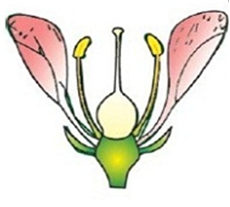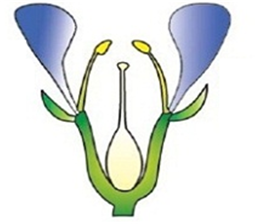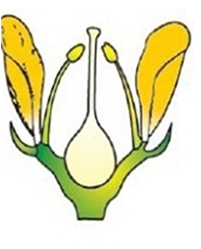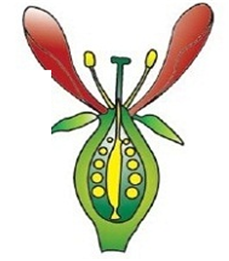 Long Answer Type
Long Answer TypeDefine the term inflorescence. Explain the basis for the different types inflorescence in flowering plants.
Describe the arrangement of floral members in relation to their insertion on thalamus.
Based on the position of the calyx, corolla, and androecium with respect to the ovary on the thalamus, the flowers can be grouped into three categories that are hypogynous, perigynous, and epigynous.
Hypogynous flowers – In this the ovary occupies the highest position on the thalamus while other floral parts are situated below it. In such flowers, the ovary is superior. e.g., China rose, mustard etc.
Perigynous flowers: The ovary is situated at the centre and other floral parts are arranged on the rim of the thalamus. The ovary here is said to be half inferior. e.g., plum, rose, peach. 

Epigynous flowers: The thalamus grows around the ovary fusing with its wall. The other floral parts are present above the ovary. Hence, the ovary is said to be inferior e.g., flowers of guava and cucumber. 
 Short Answer Type
Short Answer TypeWrite the floral formula of a actinomorphic, bisexual, hypogynous flower with five united sepals, five free petals, five free stamens and two united carples with superior ovary and axile placentation.
 Multiple Choice Questions
Multiple Choice QuestionsRearrange the following zones as seen in the root in vertical section and
choose the correct option.
A. Root hair zone
B. Zone of meristems
C. Rootcap zone
D. Zone of maturation
E. Zone of elongation
A, B, C, D, E
D, E, A, C, B
E, D, C, B, A
Proximal
Distal
Intercalary
Anywhere
The mature seeds of plants such as gram and peas, possess no endosperm, because
These plants are not angiosperms
There is no double fertilization in them
Endosperm is not formed in them
Endosperm gets used up by the developing embryo during seed development
Roots developed from parts of the plant other than radicle are called
Taproots
Fibrous roots
Adventitious roots
Nodular roots
Venation is a term used to describe the pattern of arrangement of
Floral organs
Flower in inflorescence
Veins and veinlets in a lamina
All of them
Endosperm, a product of double fertilization in angiosperms is absent in the seeds of
Gram
Orchids
Maize
Castor
Many pulses of daily use belong to one of the families below (tick the correct answer)
Solanaceae
Fabaceae
Liliaceae
Poaceae
